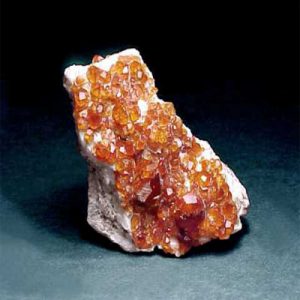Spessartine (Garnet)
Spessartine, also called Spessartite, is a member of the Garnet Group of minerals that includes Almandine, Andradite, Grossular, Pyrope, Spessartine and Uvarovite. Spessartine is fairly rare as a gem Garnet, and one of the most beautiful. Large gems are very rare and usually quite dark. The finest color is an orangy red, as exemplified by material from Ramona, California, USA and Amelia, Virginia, USA. A red-brown tint indicates a higher content of Almandine, accompanied by a higher refractive index; pale to bright orange colors are closer to pure Spessartine. Bright orange Spessartine Garnets are often called Mandarin Garnets. Spessartine as a component of Almandine gems tends to add a lively reddish tinge of color.
Rare color change Garnets with large amounts of vanadium (V) and chromium (Cr) have been reported from East Africa. These are primarily Spessartine, with an unusually large component of Grossular. There are generally two types of color change displayed: either greenish yellow-brown in fluorescent light to purplish red or reddish orange in incandescent light; or light bluish green in fluorescent light to purplish red or red in incandescent light. So-called Alexandrite-like Garnets are also found from Bekily, Madagascar. These gems display a distinct color change from violet-red to blue-green.
Spessartine, like other garnets, forms rounded crystals with 12 rhombic or 24 trapezoidal faces or combinations of these and some other forms. This crystal habit is classic for the Garnet minerals. Spessartine is formed in manganese rich metamorphic environments and in some granitic pegmatites.
Distribution: While a less-common garnet, nevertheless many localities. From Aschaffenburg, Spessart Mountains, Bavaria, Germany. On Seriphos, Cyclades Islands, Greece. In the USA, in Leiper’s quarry, Avondale, Delaware County, Pennsylvania; the Rutherford mine, Amelia, Amelia County, Virginia; in the Ramona and Pala districts, San Diego County, California; from the Thomas Range, Juab County, Utah; at Ely, White Pine County, Nevada; from near Nathrop, Chaffee County, Colorado. In Brazil, from Nangue and Urucum, Minas Gerais, and at Carnaúba, near Picui, Rio Grande do Norte. From Marienflüss, Namibia. At Tsilaizina and Anjanabonoina, Madagascar. In the Gilgit district, and at Dusso, Baltistan, Pakistan. From Broken Hill, New South Wales, Australia. At Wada-toge Pass, Nagano Prefecture, Japan.
| Chemical Formula: | Mn2+3Al2(SiO4) |
| Manganese Aluminum Silicate | |
| Molecular Weight: | 495.03 gm |
| Composition: | Manganese | 33.29 % | Mn | 42.99 % | MnO |
| Aluminum | 10.90 % | Al | 20.60 % | Al2O3 | |
| Silicon | 17.02 % | Si | 36.41 % | SiO2 | |
| Oxygen | 38.78 % | O | |||
| 100.00 % | 100.00 % | = TOTAL OXIDE |
| Crystallography: | Isometric – Hexoctahedral |
| Crystal Habit: | Commonly as euhedral crystals, dodecahedra or trapezohedra, or in combination with other cubic forms, to 10 cm. Fine or coarse granular, compact, massive. |
| Twinning: | None |
| Cleavage: | None (?) |
| Fracture: | Irregular/Uneven to Conchoidal |
| Tenacity: | Brittle |
| Moh’s Hardness: | 7.0 – 7.5 |
| Density: | 4.190 (g/cm3) |
| Luminescence: | None |
| Radioactivity: | Not Radioactive |
| Color: | Red, reddish orange, yellow, yellowish brown, reddish brown, brown, black; pale pink to pale brown in thin section, may be sectored. |
| Transparency: | Transparent to Translucent |
| Luster: | Vitreous |
| Refractive Index: | 1.800 Isotropic |
| Birefringence: | 0.000 (Isotropic) |
| Dispersion: | Weak |
| Pleochroism: | None |
| Anisotrophism: | May show weak anisotropism. |


